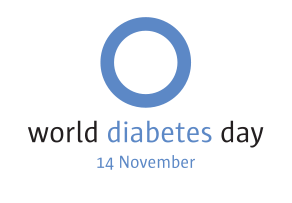The fact is, most people just don’t know enough about diabetes. It’s been suggested that 850,000 people in the UK alone have the condition without knowing it, while research shows that three in ten adults in the US have undiagnosed diabetes. Diabetes awareness is a huge problem; every November, the diabetes community comes together to do something about it. Events are organised, activities planned, and campaigns devised, all with the aim of giving diabetes a bigger presence in the public consciousness.
At the centre of it is World Diabetes Day. Taking place on the 14th of November in honour of Sir Frederick Banting (one of the first scientists to use insulin on humans), it engages people throughout the world in response to growing concerns about the disease.
In March 2014, Diabetes.co.uk started the #BloodSugarSelfie campaign. By encouraging people with diabetes to share photos of themselves with their blood sugar readings, we hoped to achieve several things: firstly, to show the extent to which diabetes can cause blood sugars to fluctuate; to illustrate that people with diabetes have to pay close attention to their blood glucose levels every single day; and to show the members of our community that they are never alone with their condition.
It worked. 1.2 million people saw the hashtag over the first two days, and 1,500 people sent us their selfies on social media. In just four days, the campaign raised £4,279 for diabetic charities.
In November we brought it back for World Diabetes Day. The hashtag was seen a staggering 4,239,432 times. 517 selfies were sent in over a 24-hour period (including one from Chaka Khan), smashing the previous record.
Since 2006, the global symbol of diabetes has been a blue circle; a number of the World Diabetes Day events incorporated the colour. The #BlueStreakChallenge invited people to add a streak of blue to their hair to show support for loved ones with diabetes. For the spectacular World Diabetes Day Blue Monument Challenge, iconic buildings and sites were illuminated throughout the world. There are over 1,000 examples in more than 80 countries of buildings embracing blue, including the London Eye, Brisbane City Hall, and the Sears Tower in the US.
Then there’s the #FreeDiabetics movement, which draws attention to the difficulty of managing diabetes by encouraging people with type 1 diabetes to take “mug shot” photos of themselves. Their crime? Type 1 diabetes. The sentence, the pictures explain, is life. In stark terms, the campaign reminds us that a cure is urgently needed.
#Insulin4All puts the “world” back into World Diabetes Day campaigning. It was created through a collaboration by T1International and The Pendsey Trust, and its aim is to increase the availability and affordability of healthcare – particularly life-saving insulin – throughout the world. Special emphasis is placed on those areas of the world in which people can’t afford the treatment they need.
World Diabetes Day was created in 1991 by the International Diabetes Federation and the World Health Organisation as a response to the exponential rise of diabetes. Over the past 23 years, the message has spread: awareness of the escalating health threat is higher than ever.
And you’ve all been a part of it. If you’ve ever offered advice on a forum thread, or reached out to let someone with diabetes know that they are not alone with their condition: even the seemingly small contributions can make a huge difference. Thank you for being part of this extraordinary journey. Let’s keep working to give diabetes the attention it deserves, until a cure is found.



